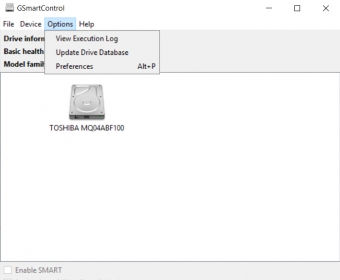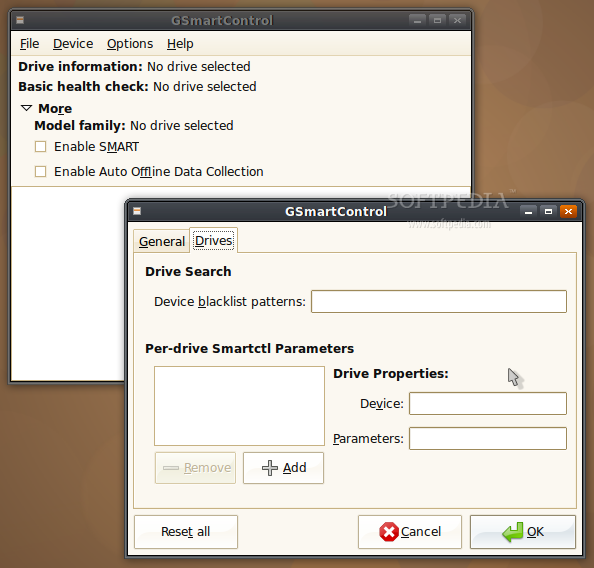- Gsmartcontrol Mac Download Full
- Gsmartcontrol Mac Download Windows 10
- Gsmartcontrol Mac Download Software
What is SMART?
Short answer: SMART is a technology which provides hard disk drives withmethods to predict certain kinds of failures with certain chance of success.
Long answer: read below.
Self-Monitoring, Analysis, and Reporting Technology, or SMART, is amonitoring system for hard drives to detect and report various indicators ofreliability, in the hope of anticipating failures. SMART is implemented insidethe drives, providing several ways of monitoring the drive health. Itmay present information about general health, various drive attributes (forexample, number of unreadable sectors), error logs, and so on. It may alsoprovide ways to instruct the drive to run various self-tests, which may reportvaluable information. It may even automatically scan the disk surface in whenthe drive is idle, repairing the defects while reallocating the data to more safeareas.
Download GSmartControl for free. Hard disk drive and SSD health inspection tool. GSmartControl is a graphical user interface for smartctl. It allows you to inspect the hard disk and solid-state drive SMART data to determine its health, as well as run various tests on it. GSmartControl 64 Bit. GSmartControl is a graphical user interface for smartctl allowing you to inspect your hard disk and solid-state drives SMART data to determine its health, as well as run various tests on it. 32 Bit available. GSmartControl supports ATA drives (both PATA and SATA), various USB to ATA bridges and drives behind some.
While having SMART sounds really good, there are some nuances to consider. Oneof the common pitfalls is that it may create a false sense of security. Thatis, a perfectly good SMART data is NOT an indication that the drive won't failthe next minute. The reverse is also true - some drives may function perfectlyeven with not-so-good-looking SMART data. However, as studies indicate, givena large population of drives, some SMART attributes may reliably predictdrive failures within up to two months.
Another common mistake is to assume that the attribute values are the realphysical values, as experienced by the drive. As manufacturers do notnecessarily agree on precise attribute definitions and measurement units, theexact meaning of the attributes may vary greatly across different drivemodels.
At present SMART is implemented individually by manufacturers. While someaspects are standardized for compatibility, others are not. In fact, mostmanufacturers refer the users to their own health monitoring utilities andadvice against taking SMART data seriously. Nevertheless, SMART may prove aneffective measure against data loss.
Yet another issue is that quite often the drives have bugs which preventcorrect SMART usage. This is usually due to buggy firmware, or themanufacturer ignoring the standards. Luckily, smartmontools usually detectsthese bugs and works around them.
Command Line Options
GSmartControl inherits options from GTK+ and other libraries, so be sure torun it with --help option to get a full list of accepted parameters.
Note: The Windows version may not have a text output at all, so --help andsimilar arguments won't have any effect.
The most important parameters are:
-?, --help - Show help options.
-l, --no-locale - Don't use system locale.

Gsmartcontrol Mac Download Full
-V, --version - Display version information.
--no-scan - Don't scan devices on startup.

--no-hide-tabs - Don't hide non-identity tabs when SMART is disabled. Useful for debugging.
--add-virtual - Load smartctl data from file, creating a virtual drive. You can specify this option multiple times.
--add-device - Add this device to device list. The format of the device is '<device>::<type>::<extra_args>', where type and extra_args are optional. This option is useful with --no-scan to list certain drives only. You can specify this option multiple times.
Example: --add-device /dev/sda --add-device /dev/twa0::3ware,2 --add-device '/dev/sdb::::-T permissive'
-v, --verbose - Enable verbose logging; same as --verbosity-level 5.
-q, --quiet - Disable logging; same as --verbosity-level 0.
-b, --verbosity-level - Set verbosity level [0-5].
Smartctl Options
GSmartControl tries its best to guard the user from having to specify smartctloptions. However, this is not always possible due to drive firmware bugs,unimplemented features, and so on. The smartctl manual page contains all theinformation you may need when dealing with smartctl.
Additional information is available at https://www.smartmontools.org/
Permission Problems
You need to be root/Administrator to perform anything useful with GSmartControl. This is needed because most operating systems prohibit direct access to hardware to users with non-administrative privileges.
In Windows, UAC is automatically invoked when you run it.In other operating systems, running gsmartcontrol-root (or using the desktop icon) will automatically launch gsmartcontrol using the system's preferred su mechanism - PolKit, kdesu, gnomesu, etc...
Please don't set the 'setuid' flag on smartctl binary. It is considered a security risk.
Enable SMART Permanently
Specifications say that once you set a SMART-related property, it will bepreserved across reboots. So, when you, say, enable SMART and AutomaticOffline Data Collection, both will stay enabled until you disable them.
However, BIOS, your operating system, your other operating systems (ifpresent), and various startup programs may affect that. For example, BIOS mayenable SMART each time you start your computer, so if you disabled SMARTpreviously, it will be re-enabled on reboot.
The easiest way to work around this is to set the desired settings on systemstartup. You may use smartctl or smartd to do that. For example, to enableboth SMART and Automatic Offline Data Collection on /dev/sda, one would writethe following to the system startup script (e.g. boot.local, rc.local orsimilar on Linux):
smartctl -s on -o on /dev/sda
Gsmartcontrol Mac Download Windows 10

Gsmartcontrol Mac Download Software
For more information, see smartctl and smartd documentation.